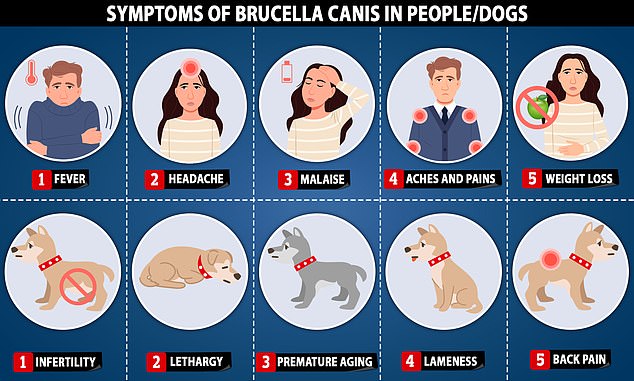Two South Carolina households, a number of of their pets, and veterinarians have been uncovered to harmful micro organism after caring for an contaminated canine and her puppies.
A stray canine was adopted first by a foster household after which by a everlasting household, and was discovered to have the micro organism Brucella canis, which triggered the loss of life of her kittens and left her infertile.
B. canis can unfold to individuals by way of an contaminated canine's bodily fluids. In accordance with the CDC report, the foster household that raised the canine dealt with her aborted puppies with out sporting protecting gear, elevating fears that they could have been contaminated.
In accordance with the CDC warning, the micro organism was not present in both of the 2 households.

Brucella canis is a canine illness discovered primarily in animals imported from Jap Europe. It could actually additionally infect individuals (inventory picture)

Brucella canis can infect each people and canine, however the signs differ
Final September, the South Carolina Division of Well being and Environmental Management was notified by a veterinarian that a number of individuals had come into contact with a canine that was discovered to be contaminated with the micro organism. The canine was a pregnant stray that had miscarried.
In August the canine wandered onto the property of a household of 4 who had a canine of their very own. They fostered the canine for 2 weeks, after which the canine was adopted by a household of 5, which included an toddler and a baby, in addition to two canine and two ferrets.
When the canine's new household observed vaginal discharge and realized that her puppies had just lately died, they took her to the vet. The vet ran a B. canis screening take a look at, which got here again constructive.
Canines can get this an infection by mating with an contaminated animal or by coming into contact with contaminated semen, vaginal or menstrual secretions. If an contaminated canine is pregnant, she will transmit the micro organism to her puppies throughout being pregnant, throughout start or once they drink her milk.
An infection in people happens when materials contaminated with Brucella canis comes into contact with individuals's mucous membranes, akin to their eyes and mouth, or by way of an open wound on their pores and skin.
Individuals might also grow to be contaminated with Brucella canis from different organic materials excreted by contaminated canine, akin to urine or feces, though that is most unlikely.
In accordance with the CDC: 'A complete of 17 individuals and 5 animals got here into contact with the canine, together with a foster household (and their canine), an adoptive household (and their two canine and two ferrets), and eight workers of the veterinary clinic.'
The company stated three members of the adoptive household had straight dealt with the aborted materials and the puppies with out PPE. As a result of these high-risk exposures, they got post-exposure preventive medicine and monitored for signs for twenty-four weeks.
Signs usually develop inside three to 4 weeks of an infection.
'All different contacts, together with the foster household and their canine, have been low danger, together with when accumulating samples utilizing PPE, feeding, petting and strolling the canine outdoors or, within the case of ferrets, informal family contact.
'They have been instructed to watch for signs. By week 24, not one of the contaminated people reported signs in themselves or their pets.'
The canine was humanely killed, which is the one acknowledged therapy for an contaminated canine.
Nevertheless, no deaths have been reported attributable to B. canis an infection. Most infections are gentle and might be handled with antibiotics. Nevertheless, severe infections of the center lining, bone, mind tissue, and blood have been reported.


